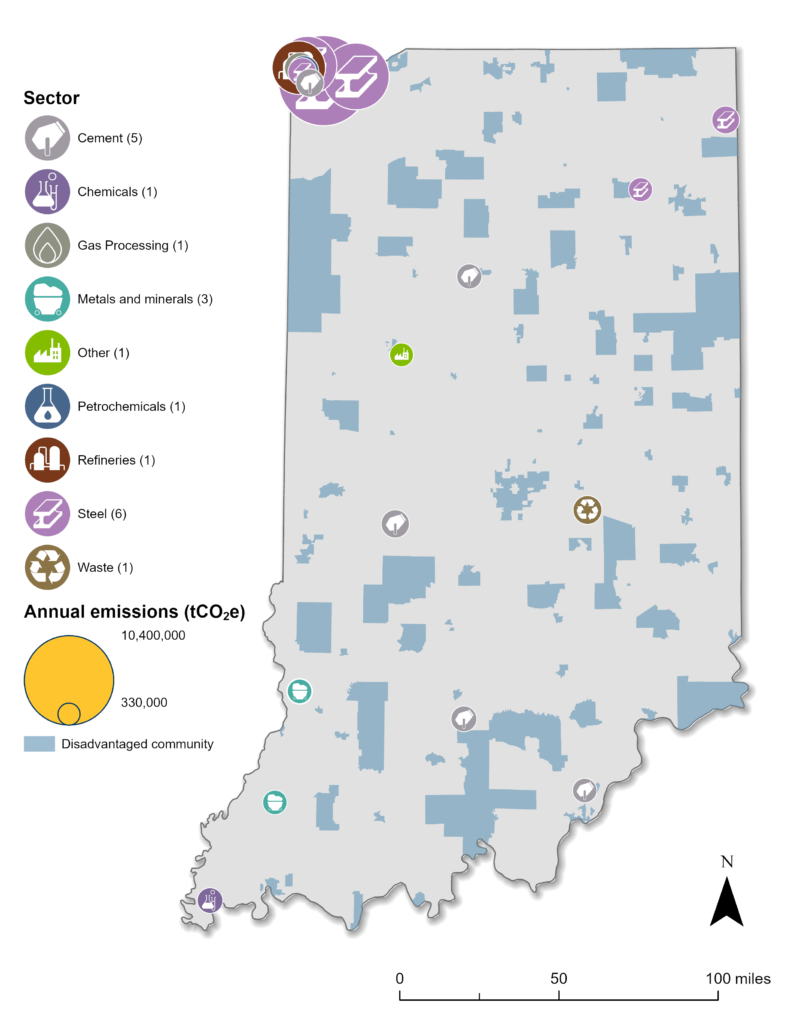Indiana
Indiana’s industrial emissions exceed those of all but a handful of states. The state’s steel industry has been a fixture of life in Gary and northwest Indiana for more than a century. Metal production accounts for more than half of industrial emissions. Minerals (cement and lime production), agricultural processing, oil and gas refining, and waste processing also generate significant emissions. Industrial facilities are primarily located in the northern and central portions of the state, especially in and near Gary, Fort Wayne, Kokomo, and Indianapolis.

- This map shows the top 20 emitters, coded by industrial sector. The size of the circles corresponds to emissions: the larger the circle, the higher the emissions.
- Disadvantaged communities (as determined by the federal government) are shaded blue.

- The inner circle provides a visual representation of the share of emissions generated by each industrial sector.
- The outer circle also indicates the share of a sector’s emissions generated in disadvantaged communities.
STATE ENERGY POLICY:
Examining a state’s broader energy policy landscape is helpful when considering policies to support industrial innovation. Indiana has not established greenhouse gas emissions targets or a clean heat standard. Indiana has established voluntary clean energy standards. While these formal commitments are not prerequisites for innovative industrial policy, they can provide a supportive framework. In addition, streamlining permitting and establishing an efficient, transparent appeals process that engages local communities early while giving clarity and assurances to project developers are key components of effective state energy policy. Discussions around innovative industrial policy present an opportunity for broader conversations about state energy policy to ensure a mutually reinforcing strategy.
LEGISLATIVE context & opportunity:
Let us know if you are aware of additional legislation advancing industrial innovation in Indiana that should be featured. The context below is not exhaustive and serves as an example of recent policies and programs and where there may be future opportunities:
- Midwest Alliance for Clean Hydrogen (MachH2): Indiana and five other states are part of the Midwest Alliance for Clean Hydrogen. Independent of the outcome of the regional hubs, there is strong interest in building a clean hydrogen economy in the region.
- Carbon management technologies are another opportunity to reduce industrial emissions in the state. Learn more about the economically feasible subsectors in Indiana and facilities that qualify for the federal 45Q tax credit.
- S.B. 241 advanced the construction of a carbon capture and sequestration pilot project at a West Terre Haute-based fertilizer plant. Expected to come online in 2026, it will be Indiana’s first fertilizer plant, providing domestic, low-cost, zero-carbon fertilizer.
- A factsheet by the Renewable Thermal Collaborative identifies electrification of Indiana’s steel, soybean oil, and wet corn milling subsectors as opportunities to reduce emissions significantly.
Explore recent legislation in Indiana and all 50 states by clicking on a specific year: 2025 legislation, 2024 legislation, 2023 legislation.
